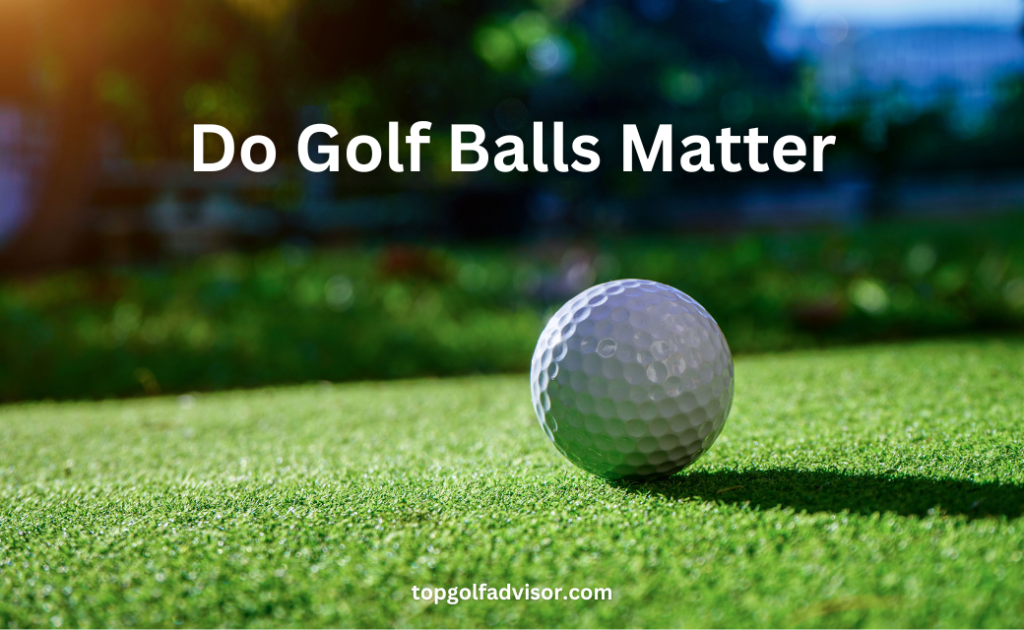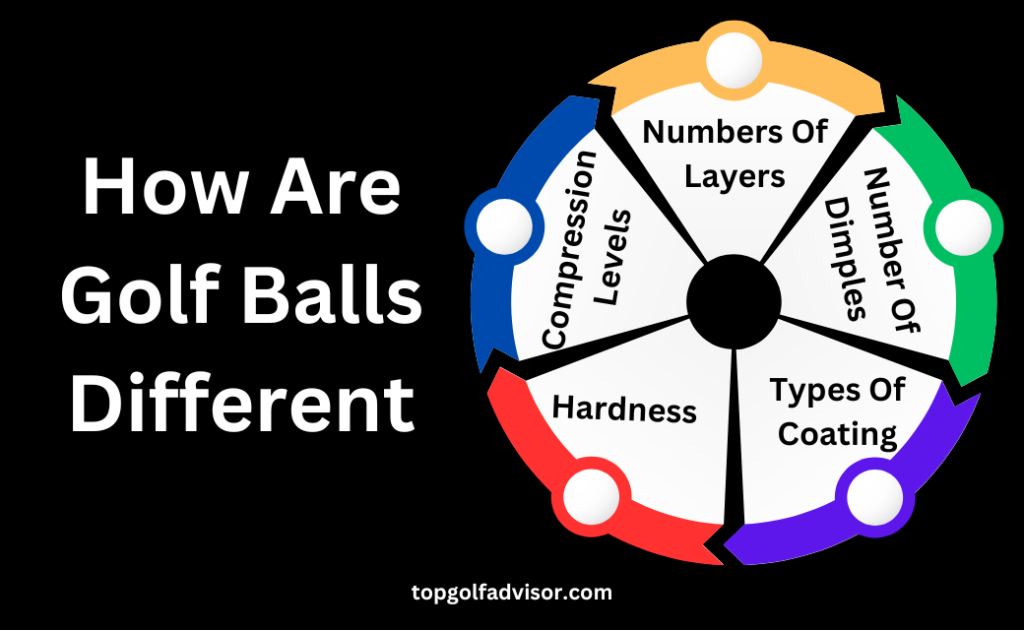There are numerous varieties of golf balls, as anyone who has visited a golf shop will attest. It might have even seemed too much. How can you decide which one to choose? But the real question is, do golf balls matter?
Your game can be affected by playing the ball you found among the shrubs during your previous round. Each golf ball has a tiny variation, and in this article, we’ll discuss whether or not it matters which ball you play and, if it does, why.
Generally speaking, as you improve, the golf ball you use becomes more important. The ball you use won’t affect your game much while starting out, but you should get a better ball if you begin to shoot in the eighties.
To be clear, using the incorrect golf ball won’t instantly improve your game. It will only improve your game by ten strokes, too. That being said, at different phases of your golf game, there are certain things you should be aware of. They could prevent several strokes and save you some money.

How Are Golf Balls Different?
There are numerous factors to take into account when it involves golf balls. Different layers, spin rates, compression ratings, and other factors are included in golf balls.
Most players use the ball they found in the bushes during the previous round. That’s probably not the ideal way to get better, but it’s okay if you just want to hack the object.
Balls are manufactured for different persons, which explains why they are diverse. The things a scratch golfer needs with the ball to do are probably other than those who are just starting. Also, check our blog on Are Nitro Golf Balls Any Good.
Numbers Of Layers:
The fact that multiple materials are used to make golf balls surprises many people. Golf balls have numerous layers of different materials, just like baseballs and bowling balls. The interior of a golf ball would resemble an Earth core diagram if cut in half!
Every golf ball has a tiny ball, or core, in the middle, like a peach pit. Less complex golf balls contain a core surrounded by just one or two layers of material.
The best for novices and recreational golfers are these. They’re also the most affordable choice! There are more intricate balls with several layers; these are usually more expensive and require extra care when playing.
Multi-layer balls are often exclusively used by players at the semi-professional or elite levels. If you have yet to arrive, choose the casual option. Everybody has to start somewhere.
Number Of Dimples:
The surface of golf balls isn’t smooth; instead, they have hundreds of tiny indentations known as dimples. Many people are unaware of how important dimples are—far beyond just being attractive. Unbelievably, the quantity of dimples has a big influence on your shots.
Dimples give the ball more surface area and change how wind forces pass through it, giving it spin and distance. A ball may move farther and quicker the more dimples it has. Seasoned players prefer higher dimple counts; 500 is the maximum. Spin-tight players will frequently go for dimple counts of little more than 300.
Compression Levels:
There is typically a compression rating or number on the packaging of golf balls. The pressure the golf ball’s layers and core are under is called compression. Professionals typically choose balls with a reduction of 100 or higher, considering compression when preparing their shots.
Higher compression balls are appropriate for casual players and those with a high handicap, although lesser compression rate balls will still work fine. Professional players are the only ones for whom high-compression balls are worth the higher price. Therefore, do golf balls matter makes a big difference when it comes to compression levels.
Types Of Coating:
Two alternatives are available for ball coatings, sometimes known as cover: urethane and surly. Surlyn coatings are great for beginning golfers still learning the fundamentals since they reduce spin. For seasoned players who understand how to spin, urethane adds more spin to the ball.
Hardness:
Most golf balls feel hard, as anyone who a flying ball has ever struck can attest. But when it involves selecting a ball, there are some disparities in hardness. The ball can move farther in one direction if it is harder. A softer ball feels better when struck with a club, has more spin, and is generally better for difficult shots. According to the course and weather, professional golfers frequently use soft and hard balls. Higher handicapped players typically like a softer ball.
Your skill level will determine which ball you should play. High handicappers and novices require a few essential features at an affordable price. A better ball is required to provide low-handicap players with the greatest potential results.
The ball behaves differently when you add more layers. The performance varies when the cover material is changed. You may get better or poorer distances when the ball is flying higher. That will be covered next.

Do Golf Balls Matter For Beginners?
Newbies generally don’t need to worry about their golf ball type. You should only be concerned about an inexpensive “softer” ball. Hitting $1 Top-Flites to your heart’s content eliminates the need for chasing a $5 Pro V1 into the water.
It’s OK that, as a rookie, you will spend more time looking for your shots in forests and lakes than you will setting up birdie putts.
However, we don’t have to worry about the amount of dollars we put into the golf balls when we’re doing it. The swing that first dropped the ball into the lake needs to be fixed, and that should be our top priority.
Price should be the first consideration for a beginner when selecting a golf ball. Fortunately, almost all major golf ball manufacturers offer a low-cost ball ideal for beginners.
Do Golf Balls Matter When It Comes To High Handicapper?
High-handicap golfers should only use softer balls with low compression and spin rates. You can still get by with a novice ball even if you’ve been playing for a long time. Arguably the most important consideration for players with big handicaps should be cost. Balls wear out very rapidly, and starting balls are far less expensive. Spending a few dollars on a few one-dollar balls is preferable to spending twenty dollars on the same quantity!
Golfers who consistently shoot in the 90s and low 100s are known as high handicappers. The golf ball now becomes significant at this point.
The two main issues will continue to be cost and control. But at this stage, to make the minor tweaks to our swings that would help us become better players, we must be consistent.
Soft compression may still be helpful, but it’s time to consider the golf ball’s other features, primarily its actual manufacture.
Do Golf Balls Matter For Mid-To Low Handicappers?
A middle- or low-handicap golfer might be pickier about the kind of ball they use. You’ve acquired many skills at this level necessary for higher-end balls. Considering how infrequently you need to buy balls, investing in more costly models can be worthwhile.
While 100+ compression is overkill, mid- and low-handicap players might prefer a multilayer ball with 400–500 dimples and a middle–to–—high compression rate. These players would still perform well with surlyn coating but could choose urethane coating.
For players with a mid-handicap, the golf ball they use becomes increasingly important. Finding a ball that feels right and adds some regularity to your game is the most important thing to consider. Consideration should also be given to increased wedge spin.
Your irons’ grooves will provide a lot more grip, and your wedges’ spin and control will increase significantly as you get closer to the greens.
Are Golf Balls Essential For Senior Players?
Depending on what! Hardness constitutes one of the most important elements for a successful round for many older players. Even with a low handicap and plenty of expertise, senior players may still choose a softer ball.
It Is due to two factors.
- To begin with, softer balls are more comfortable to hit. It might be difficult for aging joints to experience reverberation from hitting a harder ball since it can go up the club and into your arms. Softer balls won’t travel as far, which is preferable for those with mobility issues, which is the second reason.
- High-end balls may be preferred by seniors with low handicaps who do not have joint pain or mobility issues. Everything is based on personal preference.
Which Is More Important Golf Clubs Or Golf Balls?
Whether do golf balls matter more than golf clubs in achieving lower scores has yet to be a definitive solution.
Both are necessary. After spending thousands on equipment, many golfers will only utilize balls they discover on the course.
Before utilizing a ball you discover on the course, make sure it looks in good shape and discover its qualities. Having clubs that you are familiar with and have tried shooting at the golf shop before buying is essential.
To get the most out of your golf clubs, we strongly advise having fitted golf clubs that correspond with your height and swing type.
It’s also crucial to have the appropriate ball. Use a variety of balls to practice, such as two-, three-, four-, or five-piece balls.
The optimal option should be whichever gives you the most control and satisfaction.
What Is The Impact Of Changing A Ball Mid-Round?
Do golf balls matter when you’re changing them in the middle round? Mid-round ball swapping is acceptable whether you play recreationally or in a competition. However, it is advised that you return to the same model and golf ball brand.
For instance, it would be better to go from a high-spinning four or five-piece ball to a two-piece ball with low spin and high distance. You would lose control and distance if you did this.
The characteristics of 3-5 piece golf balls are explained below.
- More technology is included in three-piece golf balls than in two-piece balls. These balls range in size from two to five pieces.
- Like a two-piece, the three-piece will be long off the tee yet controlled with a spin around the greens. These are a must-have for any golfer with a mid-handicap.
- Urethane typically creates a thin covering encircling the core of four- and five-piece balls.
- Golfers may control the ball with more spin, thanks to this. The ball is softer. These golf balls may cost more money.
Final Words
It’s critical to select the appropriate ball for your game. You gain insight into how you can hit the ball and how it will react.
A golfer will feel more at ease and acquainted if they use the same ball or one comparable. Do golf balls matter, then? Indeed, they do. If you think the same, let us know in the comments, and if you love this blog, check out some of our other works, such as How are golf balls made?
FAQs
Are nice golf balls worth it?
According to spin-rate comparisons, expensive golf balls, such as the Pro V1, produce higher spin rates off the tee and greens, resulting in superior distance control. Value balls can perform similarly to wedges, but premium balls are superior for longer shots.
How do I choose a good golf ball?
Golfers who swing the ball slower should consider going with a ball rated 80 or lower. Golfers who swing the club more quickly should seek a compression speed of 100 mph or more in their ball. For players that swing the ball at a medium speed, a golf ball with a pressure rating of 90 works best.
Do Golf Balls Matter for a Beginner?
Instead of starting with a premium ball, working yourself up to one is preferable. Different materials are involved in many golf balls designed for slower-to-moderate swinging beginners and higher handicappers than for faster-swinging players.
